Path Final
0.0(0)
0.0(0)
Card Sorting
1/105
There's no tags or description
Looks like no tags are added yet.
Study Analytics
Name | Mastery | Learn | Test | Matching | Spaced |
|---|
No study sessions yet.
106 Terms
1
New cards
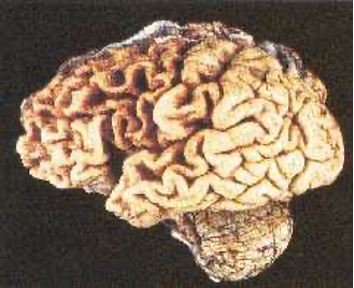
The change in the brain of this 82-year-old man is an example of
Atrophy
2
New cards
A cervical biopsy of a 24-year-old woman shows a change in the expected columnar epithelium, which has been replaced by the stratified squamous epithelium lining the mucosal surface of the endocervical glands and revealing immature cells occupying the lower two-thirds of the epithelium. What is the best designation for the change?
Dysplasia
3
New cards
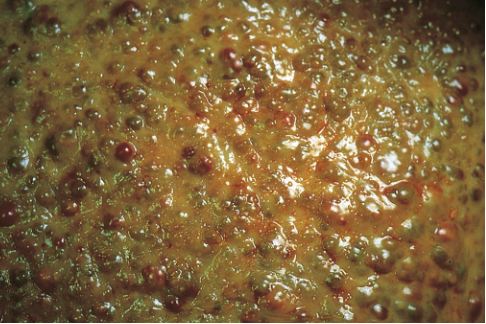
A 57-year-old woman has had increasing abdominal enlargement for six months. During the past two days, she developed a high fever. On physical examination, her temperature is 38.5° C. The abdomen is enlarged and diffusely tender and there is a fluid wave. Paracentesis yields 500 mL of cloudy yellowish fluid. The cell count is 532/μL with 98% neutrophils and 2% mononuclear cells. A blood culture is positive for Escherichia coli. The representative gross appearance of her liver is shown in the figure. Which of the following underlying diseases most commonly accounts for these findings?
Chronic Alcohol abuse
4
New cards
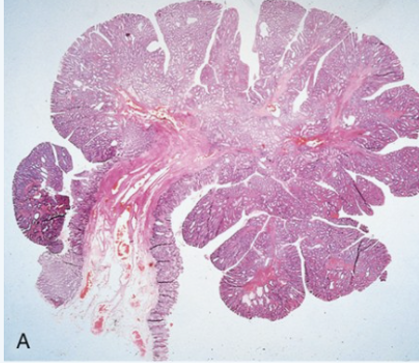
A 53-year-old woman undergoes a routine checkup. The only abnormal finding is a stool specimen that contains occult blood. Colonoscopy shows a 1.5 cm, solitary, rounded, erythematous polyp on a 0.5 cm stalk at the splenic flexure. The polyp is removed; its histologic appearance is shown in the figure at low (A) and high (B) magnifications. Her colonic lesion is most likely associated with which of the following?
Low risk for development of carcinoma
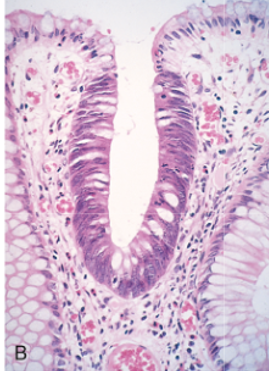
5
New cards
A 53-year-old woman with no prior illnesses has a routine checkup by her physician. She has a blood pressure of 150/95 mm Hg on examination. If her hypertension remains untreated for years, which cellular alterations would likely be seen in her myocardium?
Hypertrophy
6
New cards
A 22-year-old woman becomes pregnant. A fetal ultrasound examination at 13 weeks gestation shows her uterus measures 7 × 4 × 3 cm. At delivery of a term infant, her uterus measures 34 × 18 × 12 cm. Which of the following cellular processes has contributed most to the increase in her uterine size?
Myometrial smooth muscle hypertrophy
7
New cards
A 25-year-old woman breastfeeds her infant. On examination, her breasts are enlarged, and Milk can be expressed from both nipples. Which of the following processes in her breasts during pregnancy enabled her to breastfeed the infant?
Lobular Hyperlasia
8
New cards
A 29-year-old man sustains a left femoral fracture in a motorcycle accident. His leg is placed in a plaster cast. After his left leg had been immobilized for six weeks, the diameter of the left calf decreased in size. This change in size is most likely to result from which of the following alterations in his calf muscles?
Atrophy
9
New cards
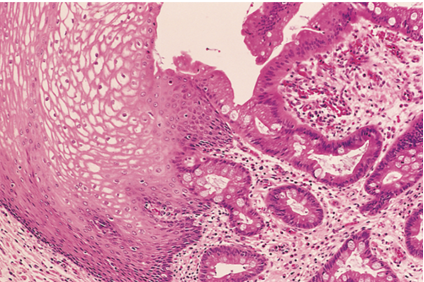
A 34-year-old obese woman has experienced heartburn from gastric reflux for the past 5 years after eating large meals. She undergoes upper gastrointestinal endoscopy, and a biopsy specimen of the distal esophagus is obtained. Which of the following microscopic changes, seen in the figure, has most likely occurred?
Columnar metaplasia
10
New cards

A screening chest radiograph of an asymptomatic 37-year-old man shows a 3 cm nodule in the middle lobe of his right lung. The nodule is excised with a pulmonary wedge resection, and sectioning shows a sharply circumscribed mass with a soft, white center. The microscopic appearance is shown in the figure. The serum interferon-gamma release assay is positive. Which of the following pathologic processes has most likely occurred in this nodule?
Granulomatous Inflammation
11
New cards
A 24-year-old, sexually active woman has experienced lower abdominal pain for the past day. Her temperature is 37.9° C, and the left lower abdomen is markedly tender on palpation. Laboratory findings include a total WBC count of 29,000/mm3 with 75% segmented neutrophils, 6% bands, 14% lymphocytes, and 5% monocytes. Laparotomy reveals a distended, fluid-filled, reddened left fallopian tube that is about to rupture. A left salpingectomy is performed. Which of the following is most likely to be seen on microscopic examination of the excised fallopian tube?
Liquefactive necrosis
12
New cards
A 68-year-old man has had worsening shortness of breath for the past week. On physical examination, his temperature is 38.3° C. On percussion, there is dullness over the left lung fields. Thoracentesis performed on the left pleural cavity yields 800 mL of cloudy yellow fluid with a WBC count of 2500/mm3 with 98% neutrophils and 2% lymphocytes. A Gram stain of the fluid shows gram-positive cocci in clusters. Which of the following terms best describes the process occurring in his left pleural cavity?
Purulent exudate
13
New cards
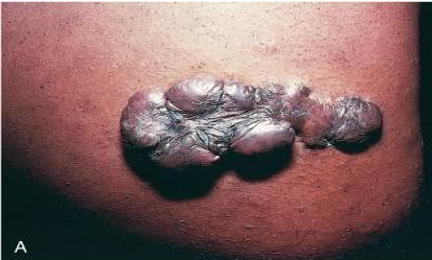
An 18-year-old man lacerated his left upper arm and required sutures. The sutures were removed one week later. Wound healing continued, but the site became disfigured over the next two months by the process shown in the figure. Which of the following terms best describes the process that occurred in this man?
Keloid formation
14
New cards
The most characteristic feature of a neoplasm in contrast to a reactive or inflammatory overgrowth, is the
Autonomous growth
15
New cards
Carcinoma of which of the following sites has the __lowest__ survival rate?
Lung
16
New cards
The word describes the undifferentiated, pleomorphic cells found in many malignant neoplasms
Anaplastic
17
New cards
What part of the microcirculation is most involved in the permeability of acute inflammation?
Venules
18
New cards
The warmth of an acutely inflamed skin lesion is due to
Hyperemia
19
New cards
Multinucleated giant cells of the foreign body type originate from
Fusion or nuclear division of macrophages
20
New cards
The principal cells of granulation tissue are
Fibroblasts and endothelial cells
21
New cards
Which of the following is the most characteristic of repair?
Granulation tissue
22
New cards
The keloid is composed predominantly of
Dense collagen
23
New cards
The least complicated repair of an incisional wound is referred to as?
Healing by primary intention
24
New cards
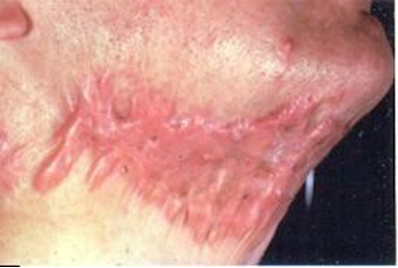
The figure below illustrates which of the following?
Hypertrophic scar
25
New cards
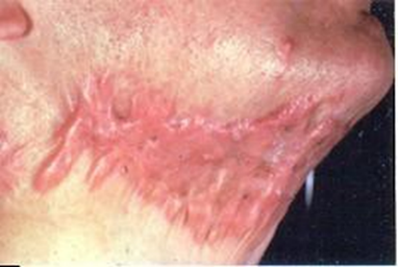
A person suffering for the condition depicted in the figure is most commonly associated with which of the following?
Thermal or Traumatic injury
26
New cards
The term cancer refers to which of the following?
A malignant neoplasm of epithelial or mesenchymal origin
27
New cards
An 18-year-old woman has a right breast tumor; the most likely diagnosis is?
Fibroadenoma
28
New cards
A malignant tumor of smooth muscle referred as?
Leiomyosarcoma
29
New cards
A 58-year obese woman developed uterine bleeding, and an endometrium biopsy showed that she had a malignant neoplasm; the most likely diagnosis would be?
Leiomyosarcoma
30
New cards
This 25-year-old woman developed a malignant neoplasm of the cervix; the most likely diagnosis is?
Squamous Cell Carcinoma
31
New cards
This 22-year-old woman developed a tumor of the ovary that contained segments of skin, hair, sebaceous glands, muscle, and gastrointestinal epithelium, a lesion of nature referred to as?
Mature Teratoma
32
New cards
Acute rheumatic endocarditis follows infections with
Group A beta-hemolytic streptococci
33
New cards
In the initial attack of acute rheumatic fever, congestive cardiac failure results from
Myocarditis
34
New cards
Which of the following is pathognomonic of active rheumatic fever?
Aschoff body
35
New cards
The most frequent clinically significant residual lesion of acute rheumatic fever is
Mitral stenosis
36
New cards
Which test is most helpful in substantiating a clinical diagnosis of infective endocarditis?
Blood cultures
37
New cards
In North America, the organism most frequently responsible for infective endocarditis is
Staphylococcus aureus
38
New cards
On her first prenatal physical exam, a 24-year-old woman was noted by her obstetrician to have a mid-systolic click on auscultation of the heart. The most likely reason for this physical finding would be
Mitral valve prolapse
39
New cards
The most common primary tumor of the heart is
Myxoma
40
New cards
The most typical location for a cardiac myxoma is
Left atrium
41
New cards
Hyaline arteriolosclerosis is characteristic of
Diabetes mellitus
42
New cards
Which is usually associated with thromboangiitis obliterans (Buerger disease)
Smoking
43
New cards
The most common cause of abdominal aortic aneurysms is
Atherosclerosis
44
New cards
The deposition of basophilic, amorphous material in the media of the femoral artery characterizes
Monckeberg sclerosis
45
New cards
Arteriosclerosis refers to a group of processes which
Have in common the thickening and loss of elasticity of arterial walls
46
New cards
Which of the following types of emboli is most common?
Fat
47
New cards
The most common cause of lobar pneumonia is
Streptococcus pneumoniae
48
New cards
A patient has Cushing syndrome. Workup reveals laboratory evidence for increased serum ACTH, and a chest x-ray reveals a solitary lung mass. The most likely diagnosis is
Small cell carcinoma
49
New cards
Asbestos workers have an unusually high incidence of
Mesothelioma
50
New cards
Generalized subcutaneous accumulation of fluid is called
Anasarca
51
New cards
Fluid in the pleural cavity is called
Hydrothorax
52
New cards
Pulmonary congestion is usually due to?
Left-sided heart failure
53
New cards
Congestion of the Liver is usually due to?
Right-heart failure
54
New cards
A hemorrhage over 1-2 cm sized subcutaneous hemorrhages is called
Ecchymoses
55
New cards
Coughing up of blood is called
Hemoptysis
56
New cards
Pulmonary thrombo-emboli usually arise from?
Venous system of the lower extremities
57
New cards
The earliest change in atherosclerosis is seen in the
Intima
58
New cards
The degree of tissue necrosis resulting from arterial occlusion is most related to
Availability of a collateral blood supply
59
New cards
The development of new blood channels through the granulation tissue replacing a thrombus in a blood vessel is known as
Recanalization
60
New cards
Which of the following types of emboli is most common?
Fat
61
New cards
Edema associated with inflammation is due predominantly to
Increased vascular permeability
62
New cards
A red infarct is seen in which of the following?
Lung
63
New cards
The 60-year-old woman has an ill-defined pulmonary mass in the peripheral surface of the right upper lobe of the lung
Adenocarcinoma
64
New cards

The diagnosis of this lesion is
Bowens Disease
(Carcinoma In-Situ; Erythroplasia of Queyrat)
(Carcinoma In-Situ; Erythroplasia of Queyrat)
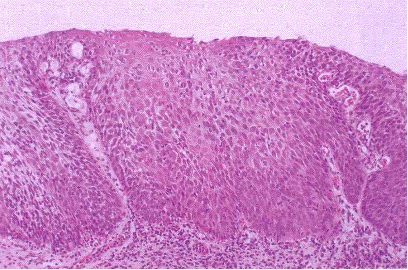
65
New cards
Of the sites listed which is the most frequent site for metastatic spread of carcinoma of the lung is
Adrenal gland
66
New cards
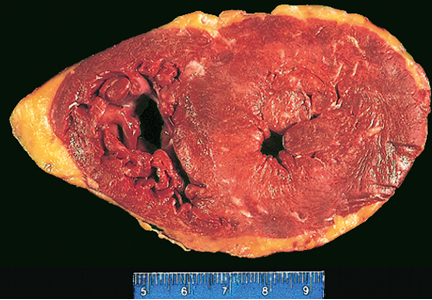
A 59-year-old man has experienced chronic fatigue for 18 months. On physical examination, he is afebrile. A chest radiograph shows bilateral pulmonary edema and a prominent left heart border. The representative gross appearance of his heart is shown in the figure. Laboratory studies show serum glucose, 74 mg/dL; total cholesterol, 189 mg/dL; total protein, 7.1 g/dL; albumin, 5.2 g/dL; creatinine, 6.1 mg/dL; and urea nitrogen, 58 mg/dL. What is the most likely diagnosis?
Systemic hypertension
67
New cards
An 84-year-old nursing home resident with a known history of stable angina has recently complained of increasing dyspnea while performing everyday tasks. One morning, she is found dead in bed. Her heart has several scattered grey-white scars at autopsy in the left ventricular myocardium. Microscopically, she has diffuse myocardial atrophy, diffuse interstitial and patchy fibrous tissue, and grossly observed scars. This patient's condition is best designated as
Chronic Ischemic heart disease
68
New cards
A 58-year-old man had a myocardial infarction one year ago, the first significant illness. He now wants to prevent another acute coronary event and is advised to begin an exercise program and change his diet. A reduction in the level of which of the following serum laboratory findings one year later would best indicate the success of his diet and exercise regimen?
Cholesterol
69
New cards
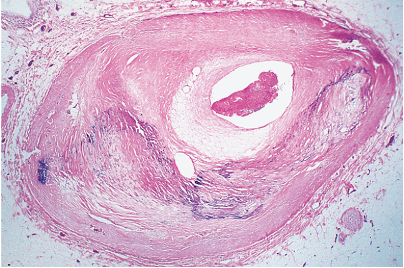
A 58-year-old woman has experienced chest pain at rest for the past year. On physical examination, her pulse is 80/min and irregular. The figure shows the microscopic appearance representative of her left anterior descending artery. Which of the following laboratory findings is most likely to be involved in the pathogenesis of the process illustrated?
Low HDL cholesterol
70
New cards
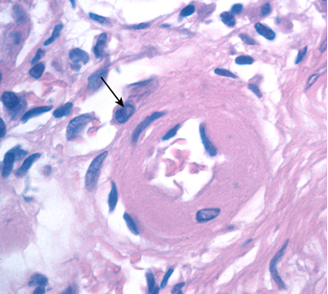
A 61-year-old man has reported increasing fatigue over the past year. Laboratory studies show a serum creatinine level of 4.7 mg/dL and a urea nitrogen level of 44 mg/dL. An abdominal ultrasound scan shows that his kidneys are symmetrically smaller than normal. The representative high-magnification microscopic appearance of the kidneys is shown in the figure. These findings are most likely to indicate which of the following underlying conditions?
Systemic hypertension
71
New cards
In Rheumatic heart disease, which of the valve are most involved
Mitral valve alone
72
New cards
This 18- year- old young lady presented with periumbilical pain localizing to the right lower quadrant; nausea and vomiting; abdominal tenderness; mild fever; elevated WBC count of 15,000-20,000 cells/μL. The most likely diagnosis is?
Acute appendicitis
73
New cards
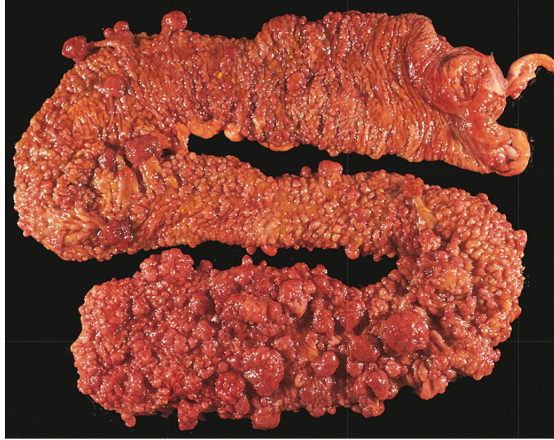
A 19-year-old man is advised to see his physician because genetic screening has detected the disease in other family members. On physical examination, a stool sample is positive for occult blood. A colonoscopy is performed, followed by a colectomy. The figure shows the gross appearance of the mucosal surface of the colectomy specimen. Microscopic examination shows these lesions are tubular adenomas. The diagnosis of the condition is?
Familial Adenomatous Polyposis (FAP) Syndrome
74
New cards
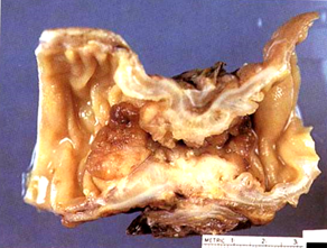
A 73-year-old man has noted a change in bowel habits for the past year. Defecation is more difficult, and the caliber of stools has decreased. On physical exam, there are no abnormal findings except for stool positive for occult blood. Colonoscopy is performed for the first time in this man, followed by colonic resection with the gross appearance shown in the figure. Which of the most likely diagnosis of this lesion
Adenocarcinoma
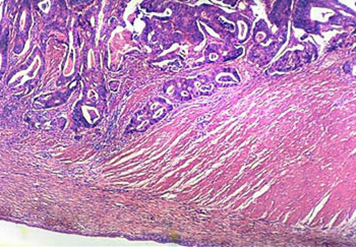
75
New cards

A routine physical examination of the 70-year-old African American man showed an indurated mass in the posterior lobe of the prostate gland on rectal examination, and laboratory screening showed an increased PSA was noted. Below is a photograph and photomicrograph of this patient's lesion, not the lesion indicated by the arrow.
Nobular hyperlasia
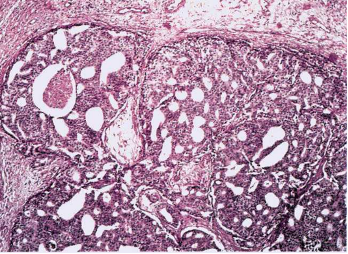
76
New cards
A 57-year-old woman has had burning epigastric pain after meals for a year. Physical examination shows no abnormal findings. Upper gastrointestinal endoscopy shows an erythematous patch in the lower esophageal mucosa. A biopsy specimen shows basal zone squamous epithelial hyperplasia, elongation of lamina propria papillae, and scattered intraepithelial neutrophils with some eosinophils. Which of the following is the most likely diagnosis?
Reflux esophagitis
77
New cards
A 51-year-old man has a sudden onset of massive emesis of bright red blood. On physical examination, his temperature is 36.9° C, the pulse is 103/min, respirations are 23/min, and blood pressure is 85/50 mm Hg. His spleen tip is palpable. Laboratory studies show a hematocrit of 21%. The serologic test result for HBsAg is positive. He has had no prior episodes of hematemesis. The hematemesis is most likely a consequence of which of the following?
Esophageal varices
78
New cards
A 68-year-old man had "heartburn" and substernal pain after meals for 25 years. For the past year, he has had increased pain and difficulty swallowing liquids and solids. On physical examination, there are no remarkable findings. Upper gastrointestinal endoscopy shows an ulcerated lower esophageal mass that nearly occludes the lumen of the esophagus. A biopsy specimen of this mass will likely show which of the following neoplasms?
Adenocarcinoma
79
New cards
A 20-year-old woman in her ninth month of pregnancy has increasing pain on defecation and notices bright red blood on the toilet paper. She has had no previous gastrointestinal problems. After she gives birth, the rectal pain subsides, and there is no more bleeding. Which of the following is the most likely cause of these findings?
Hemorrhoids
80
New cards
The type of viral hepatitis that is most like to lead to chronic liver disease
Hepatitis C
81
New cards
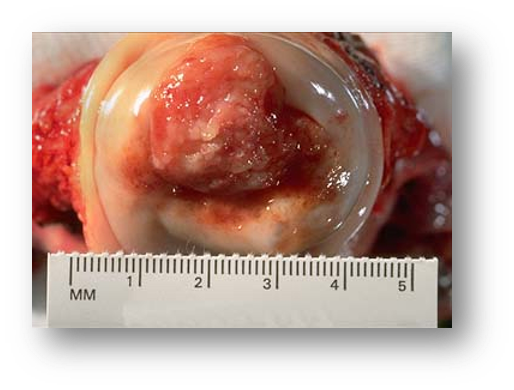
The etiology of this lesion is
Squamous cell carcinoma of cervix. Sexually-active women are at risk of being infected. HPV serotypes 16, 18,31, 33 and 35 are associated w/ high-grade dysplasia and carcinoma
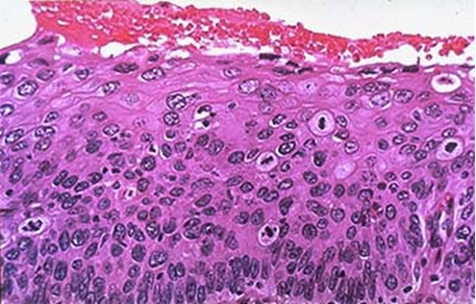
82
New cards
The terms “idiopathic” and “essential” refer only to
Used when the cause of the disease is unknown
83
New cards
The term “history” is associated with:
Symptoms
84
New cards
In the United States, which of the following represents the leading cause of death for the whole population?
Cardiovascular disease
85
New cards
A demonstrable lesions are present in patients with
Organic disease
86
New cards
The sign most closely related to pain is
Tenderness
87
New cards
…..is the prediction of the outcome of the disease, is contingent upon an accurate diagnosis, and is based upon knowledge of the natural history of the disease and its response to therapy is referred to as ?
Prognosis
88
New cards
the sequence of events in the development of disease from its earliest beginnings, including factors, which influence its development.
Pathogenesis
89
New cards
The usual course of a disease from beginning to end, without treatment, is known as the?
Natural history
90
New cards
This infant is noted to have the Sickle Cell trait upon testing, this is an example of which of following
Hereditary disease
91
New cards
The failure of development of a primitive structure of an organ is
Agenesis
92
New cards
Expansion or dilatation of small blood vessels is
Telangiectasis
93
New cards
A bad growth that is often a precursor for cancer
Dysplasia
94
New cards
The suffix ectasia refers to
Expansion or dilution
95
New cards
The suffix rhexis refers to
Rupture
96
New cards
Which of the following groups of tissue are all capable of regeneration?
Colonic mucosa, liver, renal tubular epithelium
97
New cards
An increase in the size of an organ caused by an increase in the size of the constituent cells but not an increase in their number is called ?
Hypertrophy
98
New cards
A congenital decrease in the size of a developing tissue or organ is
Hypoplasia
99
New cards
Metaplasia is thought to be caused in most cases by
Chronic irritation
100
New cards
Mature squamous epithelium replacing the pseudostratified columnar epithelium normally in bronchial lining is an example of
Metaplasia